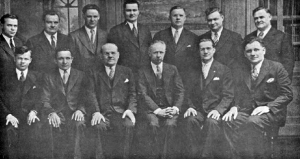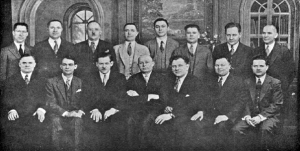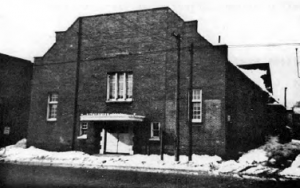Part III: the Lithuanian Community of Cleveland to World War II
Business Activities
Another area into which the Lithuanians readily moved was the establishment of their own businesses, again due to the contrast of the conditions found in Lithuania and the United States. In 1899, when there were approximately 700 Lithuanians in Cleveland, which included about 100 families, there were already thirteen Lithuanian-owned businesses, including one hardware store, one laundry, three tailors, and five taverns.[1] Of great importance to the Lithuanian business movement in Cleveland was the cooperative phase, which was initiated a few years earlier in Lithuania.[2] There were three cooperatives in Cleveland which were significant: the Cleveland Lithuanian Building and Loan Association, the Cleveland Lithuanian Societies Hall Company, and the Birutė’s Company.
The first of these came about as a result of the recognition by the Cleveland Lithuanians that they needed an institution which would allow them to obtain loans for their needs, while keeping money invested by other banks in Lithuanian hands. Therefore, under the leadership of Jonas Petrošius, meetings were held to discuss the organizational needs, and in 1909 the Cleveland Lithuanian Building and Loan Association was founded with Jonas Petrošius president, Mykolas Sacevičius vice-president, Franas Martišauskas secretary, A.B. Bartusevičius treasurer, and Vincas Debesis and Jurgis Brazaitis as assistant treasurers. In the beginning meetings were held at the apartment of the president and later at Saint George’s Hall.[3] The beginning was modest. Shares were sold at 25 cents each and at the first meeting 15 members bought a total of 72 shares.[4] But by 1911, with approximately 60 stockholders, a house was bought on 20th Street and St. Clair Avenue and five loans for a total of $9440.00 were issued. With the confidence of the institution growing among Lithuanians, the capital stock increased to $250,000 by March of 1912. By 1917 the bank’s records were given the full stamp of approval by the State of Ohio.[5] In 1919 the bank moved into a building on 68th Street and Superior Avenue, then owned by tailor J. Brazis.
The vitality of the bank was noted in a work by Fabian Kemešis dealing with Lithuanian cooperatives in the United States. He stated that the Cleveland Association would probably be the first Lithuanian local savings association in the United States to have total assets which would exceed the one million dollar mark by the end of 1924.[6]


During the depression that began in 1929, when many banks closed their doors, the Lithuanian bank was able to remain open due to its sound fiscal policies. In fact, at the annual stockholders’ meeting in January, 1937, the financial secretary reported that thousands of depositors had transferred their accounts to the Lithuanian bank, in part due to the three percent interest paid. In a speech by the president of the association, a great deal of credit was given to John DeRighter, the financial secretary, for his work in Columbus that resulted in the bank receiving government insurance.[7] Under the guidance of DeRighter a second bank was opened in September, 1956, at Euclid and Superior Avenues, and a third on East 185th Street in December, 1967. DeRighter was the executive secretary from 1927 to 1970, when he retired. One of his last efforts in this position to help the Lithuanian community was to make sure that a loan was obtained to build a new Lithuanian Community Center on East 185th Street.[8]
The second cooperative venture was the Cleveland Lithuanian Societies Hall Company. Almost from their first meeting in Cleveland, the Lithuanians felt the need to have a hall of their own. In 1908 a committee was established for such a purpose, but little came of it. Then in 1911 the Saint George’s Society invited other societies to form a committee, and finally the venture started to progress.[9] The committee began collecting funds, and in 1914 bought a plot on the corner of Superior Avenue and East 60th Street, on which three houses were located. Later however, with the difficulties of the war years, this plot of land was sold. Finally, in 1921 with improved economic conditions, a Protestant church was bought at 6835 Superior.[10] This served as a central meeting place for many years until destroyed by fire in 1971. It was rebuilt on 185th Street in 1973. There was also a second Lithuanian hall, the Lithuanian Workers Home, which was first located on Superior Avenue and later St. Clair Avenue. It was used by the liberal factions, and was liquidated in the 1960’s.
The Birutė’s Company was the third cooperative and the only one not to survive. It began selling shares in March 1919 and was incorporated that same year. The driving force behind the establishment of this cooperative bakery was Antanas Kranauskas. In 1926 the Company, which had bought a lot and built its bakery at 4608 Superior Avenue, rented the establishment to the Bach Brother’s Baking Company. Finally, in 1941 the cooperative was sold.[11]
In addition to these three cooperatives, a second Lithuanian bank, the St. Clair Savings and Loan Company, was incorporated in 1914. Located at 2006 St. Clair Avenue, it was founded by A. B. Bartusevičius,[12] and later absorbed by the Municipal Savings and Loan.[13]
Although the center for Lithuanian businesses shifted to the Superior Avenue area, there were also many others scattered throughout the city. In fact, Cleveland was considered as one of the top six cities in the nation in regard to the number of Lithuanian-owned businesses.[14] In 1951 Lithuanians owned at least 27 cafes, 23 grocery stores, 6 tailor shops, 8 barber-shops, 2 drugstores, 3 jewelry stores, 2 photo-studios, one mortuary,[15] two printing establishments, and the Cleveland Lithuanian Building and Loan Association, whose name was changed to the Lithuanian Savings and Loan, and finally to the Superior Savings. Besides this there was also the Cleveland Lithuanian John C. Smith, who founded the Fireland’s Country Store, which was to become one of the most unique and perhaps largest retail firms in Ohio selling such items as imported gourment foods, wines, confectionaries, and utensils.

- Jonas, Lietuviai, 138, 139. ↵
- Fabian S. Kemešis, Cooperation Among the Lithuanians in the United States of America, (Washington, 1924), 24. ↵
- Sakalauskas, Clevelando, 61. ↵
- Information was obtained from the bank's records. ↵
- Sakalauskas, Clevelando, 64-67. ↵
- Kemešis, Cooperation, 60. ↵
- Interview with John DeRighter on 4 April 1975. ↵
- Interview with John DeRighter on 4 April 1975. ↵
- Sakalauskas, Clevelando, 78. ↵
- V. Rocevičius, "Cleveland", 60. ↵
- Information was obtained from the unnumbered pages of the Birutė Company's minutes. ↵
- Sakalauskas, Clevelando, 108. ↵
- Interview with John DeRighter on 4 April 1975. ↵
- V.J. Jokubynas, "Amerikos Lietuviai" (American Lithuanians), Lietuviškoji Enciklopedija (Lithuanian Encyclopedia) (Kaunas, 1933), I, 434. ↵
- Širvaitis, "Cleveland's", 13. ↵
